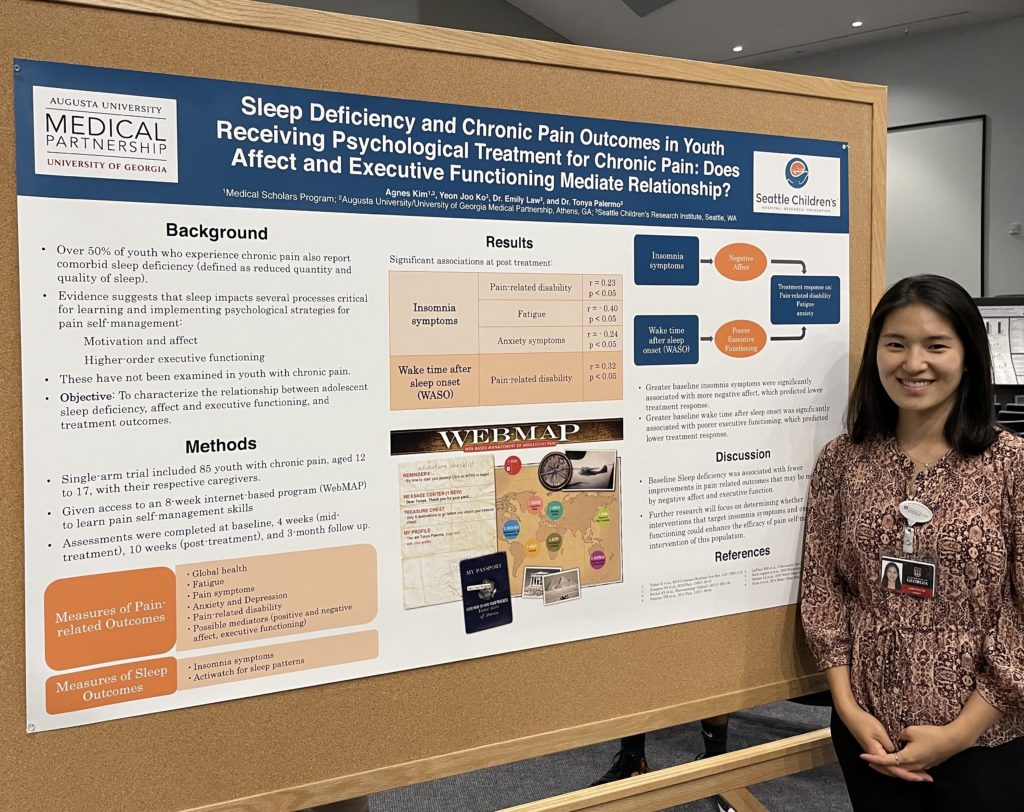-What question were you seeking to answer?
Current evidence suggests that sleep impacts several processes that are critical for learning and implementing psychological strategies for pain self-management. However, this relationship is yet to be investigated in the pediatric population. Thus, my summer research focused on how processes such as executive functioning and mood affect play a role in mediating the relationship between sleep and cognitive behavioral therapy (CBT) outcomes in adolescents with chronic pain.
-Why did you choose this topic?
I chose to research this topic with my PI, Dr. Tonya Palermo at the Seattle Children’s Research Institute because of her sustainable approach to chronic pain management in the pediatric population. Due to their inherent malleability and highly influenceable developmental stage, youth can often be more vulnerable to addictions and dependence on pain medications, especially if no other management support is offered with prescription. Moreover, they may be at high risk of carrying these habits into adulthood. In our research, we investigated methods such as improved sleep and cognitive behavioral therapy (CBT) for more sustainable and safe pain management in adolescents.
-How did you study this question?
In our study, 85 youth with chronic pain between ages 12-17 were recruited with their respective caregivers. Both parties were given 8-week online access to WebMAP, which is an interactive program that provides education about chronic pain, training in behavioral and cognitive coping skills, and knowledge about pain behaviors. While the program provided an internet CBT condition, it was separately adapted into participant and parent modules for each party. Assessments measuring pain-related outcomes and sleep outcomes were collected at different timepoints including: Baseline (pre-treatment), 4 weeks (mid-treatment), 10 weeks (post-treatment), 3-month follow-up. Pain-related outcomes included measurement of mediators (affect, executive functioning), fatigue, anxiety/depression, pain symptoms, and other pain-related disabilities. Sleep outcomes were measured with sleep diaries and an Actiwatch that participants wore to bed to detect sleep patterns.
-What did you learn through your research?
At baseline, sleep deficiency was significantly associated with lower treatment response. Specifically, greater insomnia symptoms were significantly associated with greater pain-related disability, greater fatigue, and greater anxiety at post-treatment, but not at follow-up. Greater wake time after sleep onset (WASO) on Actigraphy was associated with greater pain-related disability at post-treatment, but not follow-up. Mixed linear models examined changes in pain-related outcomes over time, and demonstrated improvements in fatigue, anxiety, and pain-disability from baseline through post-treatment and follow-up. Most importantly, results indicated that negative affect mediated the pathway between greater insomnia symptoms and lower treatment response, while poorer executive functioning mediated the pathway between WASO and lower treatment response.
-Who stands to benefit from this research?
This research hopes to benefit the youth and adolescent population who suffer from chronic pain. Unfortunately, chronic pain management is not a field that has been widely studied in the pediatric population and there are still many fundamental questions to be answered. In this project, we aim to improve both the pain and sleeping experience to stop the vicious cycle between pain and sleep deficiency in adolescent patients with chronic pain.
-What are/what would be the next steps in your research?
After learning that executive functioning and negative affect mediate the relationship between sleep and pain outcomes, we hope to study these mediators as future targets as well. In following projects, we will determine whether interventions that target insomnia symptoms and executive functioning could enhance the efficacy of pain self-management intervention for youth with chronic pain and co-morbid sleep deficiency.





